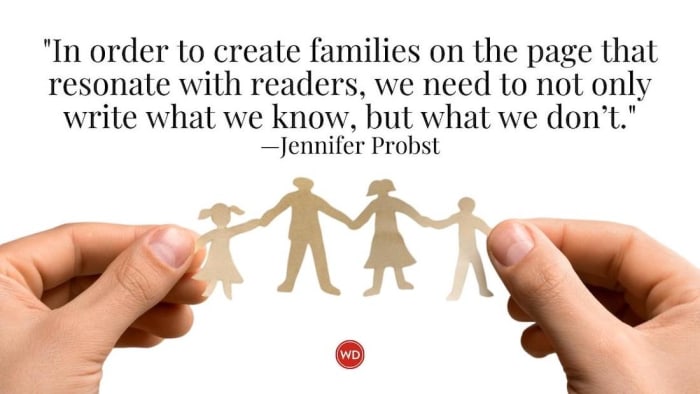3 Tips on How To Write Relatable Families in Fiction
Families are challenging.
Whether it’s parents, siblings, aunts, or uncles, the people who share our blood are not always easy to get along with, love, or even like at times. I always find it interesting when a child begins to spend time at a friend’s house. The experience is usually enlightening, because they begin to step away from their familiar world, and discover new rituals, cultures, and habits. From the food served, the interactions and dynamics of the group, to the physical home itself, we are all unique. It can be an exciting revelation to suddenly understand the world is a big place and there is not just one way to be, or do, or think. As our social world expands and we age, hopefully we grow and change ourselves.
(10 Things to Consider When Writing About Obsession in Fiction)
This makes being a writer a constantly evolving, challenging job. In order to create families on the page that resonate with readers, we need to not only write what we know, but what we don’t. How do we connect with readers of all backgrounds and experiences when we only have our own family filter? What are the steps to flesh out family members who are not only relatable, but who grow and change in the confines of an average 300-page novel?
As I recently turned in my 50th book, I began digging deeper into craft to learn more about creating new stories that not only challenge me as a writer, but keep my readers freshly engaged. There is nothing worse than publishing books where characters within families all seem alike, chasing the same goals, and struggling with the same past conflicts. That’s stale writing.
Here are three steps to make sure you create relatable, unique family members in your story.
1. Create Distinctive Voices
Who wants to read about a family where every character sounds and acts the same? Carving out dynamic, unique personalities and traits is crucial to making your story pop. A great exercise is to picture a Thanksgiving table with everyone crowded around. Imagine the conversation. Who likes to challenge the others? Who likes to quietly eat and be ignored? Who is loud and obnoxious, and says the wrong type of things? Who meddles and asks a million questions? Who is surly, rebellious, or downright miserable? Who’s the current black sheep? Who’s the golden child? Make sure when each character speaks, the reader knows who it is.
Siblings may have grown up together in the same environment, but bring their past forward in distinctive ways. For instance, if we have an alcoholic father of three siblings, each may process the experience differently. The oldest may take on a burgeoning sense of responsibility to care for others, picking love interests along the way that reflect such familiarity. The middle child may be the peacemaker, smoothing out ragged edges and choosing to “fix” people, such as friends or lovers. The youngest may be the rebel, angry about her unpredictable home life, taking this out on her relationships by consistently falling in love and moving on, as if always looking for the right fit. Setting and circumstances do not affect everyone in the same way, even in the same family.
Explore how culture and traditions affects viewpoints. Your character may grow up in an overprotective household and learn to look at the world with fear or react recklessly to new experiences because of being held back. Being raised with specific beliefs can also affect outlook and choices.
All of these factors go into the magic cauldron to make sure each sibling has a distinctive voice. Then go a bit further, creating mannerisms and quirks. One sister might twirl her hair when she lies. Another may have a sarcastic sense of humor to cover up any vulnerability. Think of the pecking order, which is also important to feel out your characters. The oldest may have been disciplined the most, while the youngest may have been freer to go with her own choices. Each will have viewed her circumstances and processed them in a unique manner, which creates different characters.
IndieBound | Bookshop | Amazon
[WD uses affiliate links.]
2. Create Conflict
Families always have conflict, even the happiest ones. The best stories bring a certain level of drama to keep readers interested and engaged. Human nature tends toward people thinking someone else’s life is better, especially with the prevalence of social media.
Let’s take an example. There are two sisters. The oldest is happily married with three children. She left her job to be a stay-at home mother. The youngest is successful in her career. She gets a big promotion, travels the world in a glamorous lifestyle, and has been dating someone everyone adores.
Our oldest sister becomes resentful of her younger sister. She begins to wonder about all the things she’s missed out on, and how different her life turned out. Meanwhile, the younger sister craves a home and family, instead of endless plane trips, hotels, and restaurant menus.
Now, create the conflict. What if the married sister discovers her husband is having an affair? She still loves him and doesn’t want to leave. She’s financially dependent on him. She’s terrified of breaking up her family she sacrificed so much for. What is she going to do?
What if our single sister realizes her job isn’t fulfilling and that she feels trapped in a cycle she created? What if a previous miscarriage caused her to doubt her ability to have a family? What if she isn’t in love with her perfect partner, but there’s no real reason to break up? What if she’s built a shiny life for herself she doesn’t even like?
We’ve all looked over and sometimes wished to experience another type of lifestyle, even if we are relatively happy with what we have. Put these sisters together and watch how silent resentment and misunderstanding of the other can grow into major conflict. Explore their relationship together and separately. Dig deep into those motivations and create conflict within families that readers can relate to.
3. Create Emotion
You have a distinct voice and interesting conflict. But I believe the most important job for a writer is to create a depth of emotion that keeps readers turning the pages. This is the good stuff and the glue that holds story together. Take our older sister who’s married and home with the kids with a cheating husband. What if she doesn’t want to share this humiliation with others and believes she can fix it? What if all these seething emotions such as anger, grief, pain and sorrow drive her every day while she tries to do her daily activities and pretend everything is fine?
Let’s look at our single sister. What if fear of the unknown keeps her paralyzed in her current life, and when she confesses it to her anyone, she is scoffed at? What if she feels horribly alone and is slowly having a breakdown? What will she choose to do next? How will these emotions drive her forward?
Within close families, there is a level of envy and jealousy that should be explored—even if it’s not from bitterness, it can come from the depths of being human.
Emotion is how we feel about our conflicts and how we handle them.
If you write about the nosy, obnoxious aunt at the Thanksgiving table who loudly asks the shy teenage niece why she gained weight, a reader may feel outrage. But if you also show how this same aunt was bullied as a kid because she was overweight, and she’s terrified of her niece receiving the same treatment, you understand her motivations and feel outrage at her behavior. Creating emotional conflict in the reader is key.
There is no black and white with emotion. There is only a wild mix of intentions, motivations, and actions. The deeper you dig to make your family human and relatable, the stronger your story will be to readers.
Use these three tips to create a family that will keep readers turning the page.




